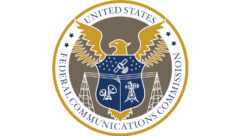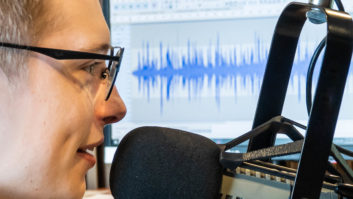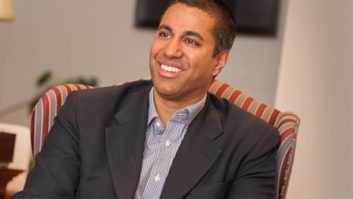One in a series of post-convention stories wrapping up the recent Radio Show in Washington.
WASHINGTON — Last year in Philadelphia, convention organizers promised the industry that the format of this year’s Radio Show would be different, and they weren’t kidding.

This device is receiving a CAP-enabled emergency alert. The NAB FASTROAD display highlighted technologies from companies like GSS, which makes the Alert FM system, and emphasized the importance of FM capability in mobile devices. Photo by Jim Peck The hotel approach for the show in Washington in 2010 was an effort to keep the event alive through difficult economic times; it also became a way to combine the Radio Advertising Bureau’s annual meeting with the NAB Radio Show.
While the combined format and hotel setting worked on several levels — sessions were packed, and attendees visibly embraced the idea of central areas to meet and network — the exhibit aspect needs changes. And while organizers haven’t made final decisions, they say they plan changes to the exhibit hall at next year’s Radio Show in Chicago.
The dual nature of the convention was apparent. National Association of Broadcasters President/CEO Gordon Smith and Radio Advertising Bureau President/CEO Jeff Haley were visible in sessions and the exhibit area. Meanwhile, politics took prominence, with lots of discussions about radio’s efforts to get in cell phones and some regarding performance rights.
The latest in emergency alerting was a big technical topic, and the advent of asymmetrical sideband transmission was big news for HD Radio, coinciding with iBiquity Digital showing the next-gen Insignia HD portable. Radio leaders sounded cautiously upbeat about the revenue outlook for commercial operators.
What follows is a sampling of news from the convention.
Radio in Devices Stressed
Haley and Smith stressed the importance of getting radio capability into mobile devices several times throughout the show.
During his opening remarks, Haley said that in 2008 at an RAB event in Atlanta, “We set a two-year goal to get radio in more devices. Radio is now in more than 70 percent of all media players and we’re on our way with cell phones.”

NAB provided prominent space to highlight FM functionality in a cell phone, including those who make embedded antennas. Photo by Leslie Stimson Smith sought to dispel what he called myths about radio in cell phones: that there is no consumer demand; that radio capability would hurt battery life; that adding radio is expensive for manufacturers; that the chip would be too big and heavy.
Most users charge their phones every day or every other day, making the battery life argument moot, according to Smith.
“Luckily for cell phone users, a radio chip is smaller than the head of a nail and weighs less than a tic tac.”
Further: “I’m told that HD Radio technology in a cell phone will be practical within about a year, creating additional services and revenue streams that become possible with a digital platform.”
The national group that represents radio reading services, the International Association of Audio Information Services, supports NAB’s efforts to get wireless carriers and cell phone manufacturers to include FM chips in cell phones. The group became the first organization from outside radio to back the industry’s effort.
The IAAIS called for congressional support, saying that having radio-enabled cell phones would be particularly useful in emergencies. Because local radio stations are free, a disabled person, who typically earns less than his or her nondisabled peers, won’t have to buy a smartphone and add an expensive monthly data plan, said IAAIS Government Relations Committee Chair Dave Noble.
NAB Launches RadioRocksMyPhone.com

BSI’s Marie Summers talks to attendees at the company’s tabletop display. © NAB The NAB launched a consumer-oriented website, RadioRocksMyPhone.com, promoting radio-capable mobile phones.
It details what NAB says are the benefits of radio-enabled cell phones, argues that the U.S. lags behind other countries with regard to the integrated technology and encourages visitors to write Congress expressing support for the technology.
Cell phone models that are radio-enabled and available in the United States are highlighted on the website and also were displayed in a prominent booth during the show.
The site references a poll commissioned by NAB and conducted by Harris Interactive, which shows that 76 percent of American cell phone owners would consider paying a one-time additional fee to gain over-the-air access to free and local radio stations through their mobile phone. The Consumer Electronics Association disputed those results, saying that its polls show Americans are not clamoring to have radio in their cell phones.
‘Franken FMs’ Are Dissed
The radio industry presumes that Channel 6 low-power television stations operating as pseudo radio stations on 87.7 MHz eventually will go away. Comments by FCC Audio Division Chief Peter Doyle at the show indicate he hopes the commission may settle the “Franken FM” issue even before the LPTV analog sunset makes it a moot point.
A noncommercial broadcaster attending a regulatory session asked Doyle when noncoms might get relief from interference from these audio signals just below the regular FM dial.
With the signals being over-modulated on these stations, Doyle replied, “they can’t possibly be operating” according to the television technical rules. He also questioned whether they’re complying with public interest considerations such as EAS.
“We are aware of the problem,” he said, which “hopefully we’ll solve before we sunset all the analog LPTVs.”
The FCC hasn’t set such a deadline, but attorneys contacted by Radio World believe it could be in 2012. The commission has said new LPTV facilities must now be digital.
Bennett Predicts No PRA Action This Year
Shortly after the convention, MusicFirst was hoping it could refocus lawmakers’ attention on passage of a performance rights bill this year, after Congress returns to Washington following the elections.

NAB President/CEO Gordon Smith listens to Republican Sen. Bob Bennett of Utah. Bennett doesn’t believe performance rights will see action when lawmakers return to Washington after the fall elections. © NAB/RAB However Sen. Bob Bennett doesn’t believe there will be action this year.
Bennett, who is leaving Congress after not being selected to stand for office again by Utah Republicans, said in a show session that the only bill that really needed to pass was a continuing resolution or “CR” to keep the government running. (It did.)
NAB President/CEO Gordon Smith, himself a former U.S. senator, said that if the elections see Republicans take back one or both houses of Congress, a new Senate majority leader or House speaker “may insist on a clean CR” so when they take office in January they can have a clean slate.
Bennett warned that if either Speaker Nancy Pelosi or Majority Leader Harry Reid loses her or his position, “They’re going to have a different agenda” when they return in November. “It’s going to get really ugly.”
Smith added, “Ugly is good for our purposes,” meaning their focus would change and performance rights would get overlooked in the shuffle.
At the same session, Michigan Democrat Bart Stupak, who’s retiring from the House, spoke about NAB’s efforts to persuade wireless companies and cell phone makers to put FM chips in their devices. He said this makes sense. But when questioned by an attendee about whether FM chips in cellphones should be mandated, Stupak predicted Congress would tell the parties to try to work out their issues before it gets to that point.
FEMA Adopts CAP; Shot Clock Begins

Al Kenyon, left, project manager, and Manny Centeno, program manager, represented FEMA’s IPAWS Program Office, National Continuity Programs. FEMA approved the latest CAP standard before the Radio Show ended, triggering the compliance clock. Photo by Jim Peck The Department of Homeland Security’s Federal Emergency Management Agency adopted the latest version of the Common Alerting Protocol, a digital message format for the Integrated Public Alert and Warning System, the next-generation emergency alert and warning network.
IPAWS incorporates and expands the EAS. Using the new CAP v1.2 standard, emergency management officials can more easily compose alerts to be sent over more devices. FEMA has an assessment program to ensure new EAS products can encode, decode and pass on new CAP EAS messages.
The adoptions means that the so-called 180-day shot clock for broadcasters to have CAP-compliant equipment in place has begun, though at deadline, an industry advisory group to the FCC had recommended the deadline be delayed. Look for more about EAS in our next issue.












